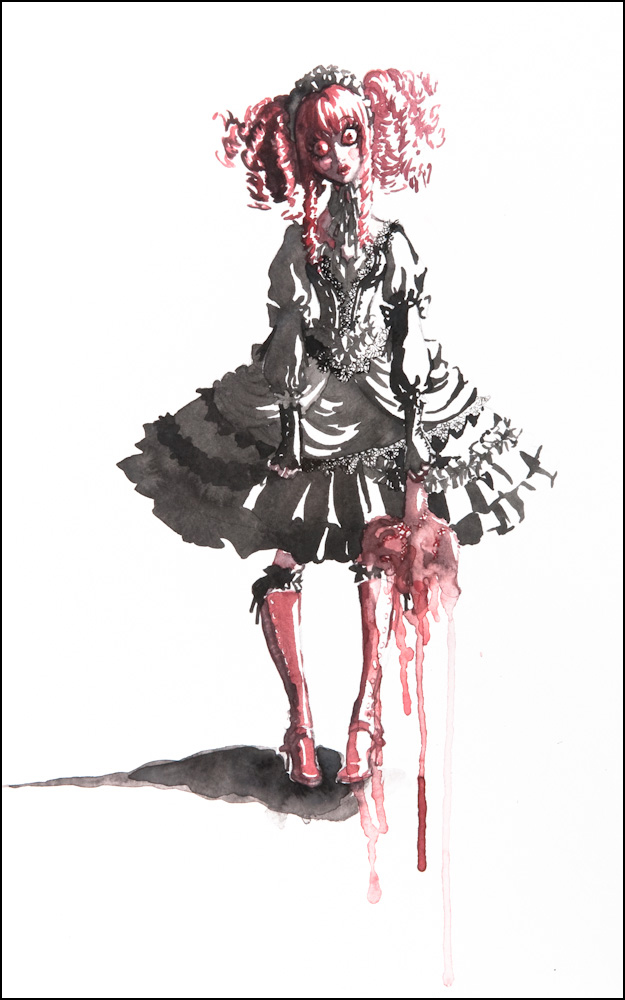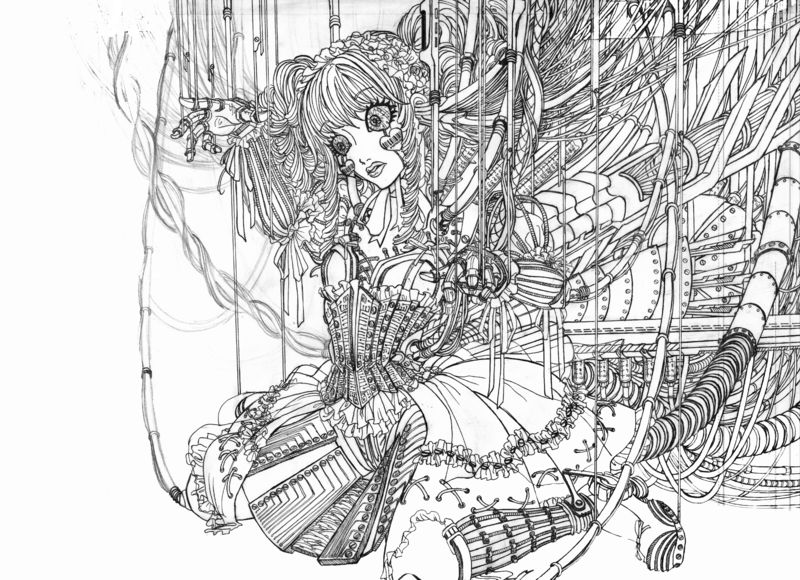Remember our Re-Designing History illustration competition? In conjunction with our current exhibition, Re-Designing History: FIDM Museum Study Collection, 1850-2000, we sponsored a competition for current FIDM students. The goal was to create a design inspired by this c. 1872 fuschia day dress. Our panel of judges selected three winners based on the following criteria: overall creativity, visual composition, and design inspiration. Thank you to the many students who submitted illustrations, and congratulations to the competition winners: Katrina Andrews (3rd Place, Fashion Design), Marc Blaskovits (2nd Place, Graphic Design) and Elizabeth Teemley (1st Place, Theatre Costume Design). As 1st place winner, Elizabeth's illustration will be on display in our gallery until Re-Designing History closes on December 17, 2010. Elizabeth describes her design process, inspiration and style in the following entry.
Hello, everyone. Elizabeth Teemley here. Thank you all for your congratulatory words and your interest in my art. I must say I was surprised, but honored, to be selected as a winner in the Re-Designing History competition. On top of winning, I have an opportunity to share a little about my art. As might be apparent in my illustration, I am inspired by anime and Japanese comics. My favorite fashion trend originates in Japan, as well. You may have heard of a style called Lolita. It is a fashion that draws primarily from Victorian children's clothing. Lolita girls are particularly obsessed with Alice in Wonderland. I, too, am inspired by Alice's innocence and how it contrasts with the somewhat dark and mysterious wonderland she enters.
 Elizabeth Teemley's 1st place illustration
Elizabeth Teemley's 1st place illustration
When I saw that there was an illustration contest, I thought, "Hey, I'm an artist, but I never enter contests. I should do it this time." So I set aside a couple hours to sit and sketch on the second floor of FIDM where the dress featured in the competition was on display. I had seen it previously when my costume history class went to discuss it. My teacher had urged all theater costume design students to enter the competition for the pride of our program. I felt I had a pretty good shot at winning so I sat down with my sketch pad. But only for a couple seconds. Then I was up, circling the dress for little details and trims I could translate into my design.
 "Cyber Lolita" This illustration is one of Elizabeth's current projects.
"Cyber Lolita" This illustration is one of Elizabeth's current projects.
It was much later that I sat down to actually paint my design. I knew I wanted to use watercolor because I had just been taught how to use it properly in my costume rendering class. I love to work in high contrast and watercolor is perfect for that. I also knew that I wanted to work in black and a purply-red inspired by the rusty fuchsia color of the original dress. I did a practice version first to decide where my light source was and how I wanted to draw the drips coming down from the teddy bear. I had little trouble rendering the Lolita's dress, but her face gave me some trouble. It was hard to find a blend of colors and contrast that was appropriate for her dress. But eventually I arrived at a combination that gives my Lolita a creepy, doll-like face.
I was really delighted with the parameters of this contest. I felt as though I had complete freedom to draw in my personal style, but I was able to draw inspiration from one of my favorite periods in history. I also feel that Lolita makes an interesting comment about the Victorian era. Lolita originated with Japanese youth that felt suppressed by their school uniforms and a lack of freedom to express themselves. It is entirely nonfunctional and individual, the opposite of expectations from Japanese society. Strangely, the fashion is drawn from a period where women had very little importance and were tightly restricted in undergarments and layers of fabric. I took all of these elements and presented my own interpretation. My Lolita is doll-like, curiously lifeless, as though someone dressed her up, gave her a teddy bear, and set her down: an idealized puppet, only able to do what she's told. It makes a comment on women in society in both the Victorian era and in Japanese society while being a representation of my design aesthetic and my art style.
I am always interested in feedback and viewer's interpretations. I do hope you are able to visit the FIDM Museum in person to view all three of the winning illustrations and the beautiful collection on display. Once again thank you for the opportunity to share with you. It has been my pleasure.




Love the strong light source, the dramatic contrast, the soft bleeding of the watercolor, and the emotion of the face. Always have loved your work from day one that I met you. I am very excited for you and can’t wait to see more. Especially would love to see you make a 3-d doll from this.
Tereese Radenbaugh